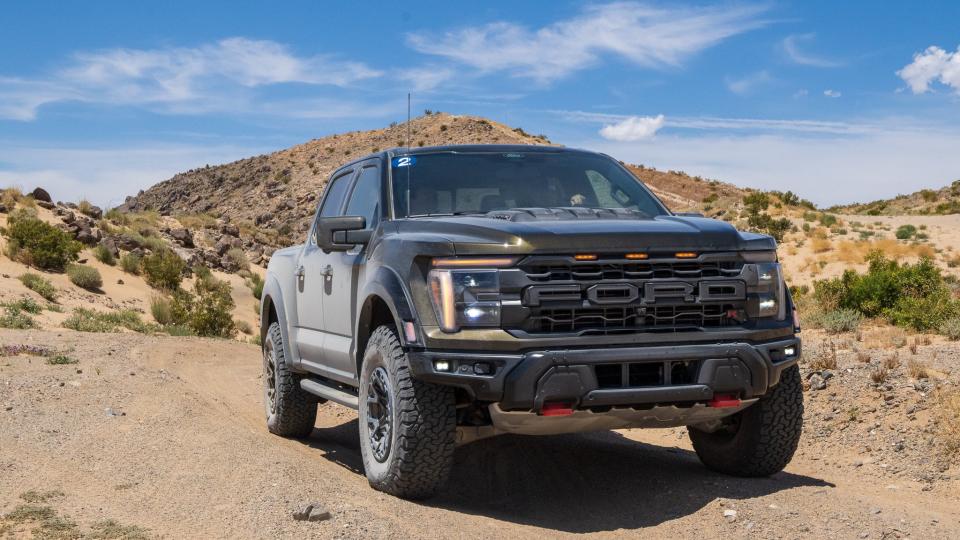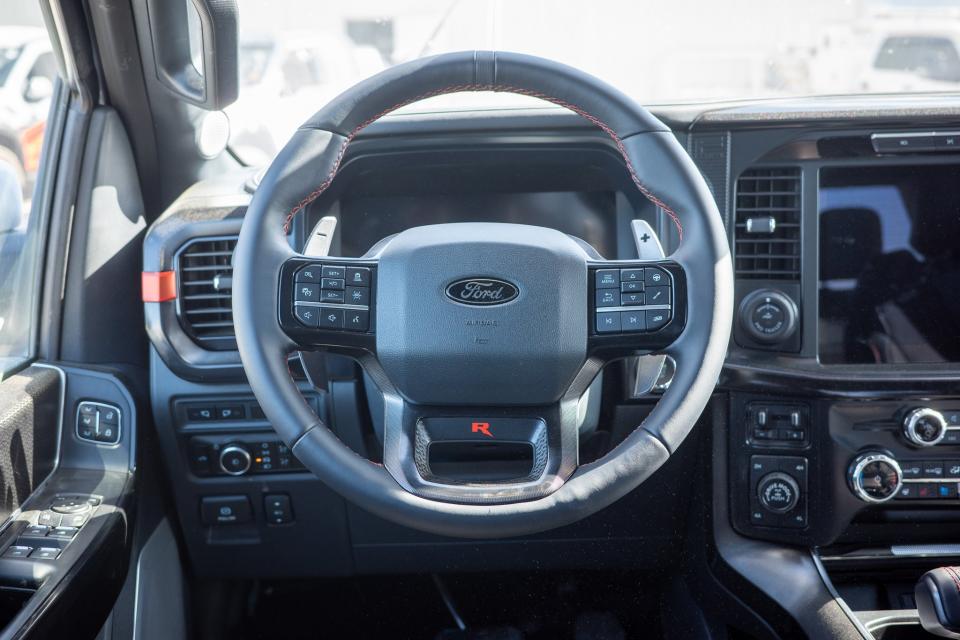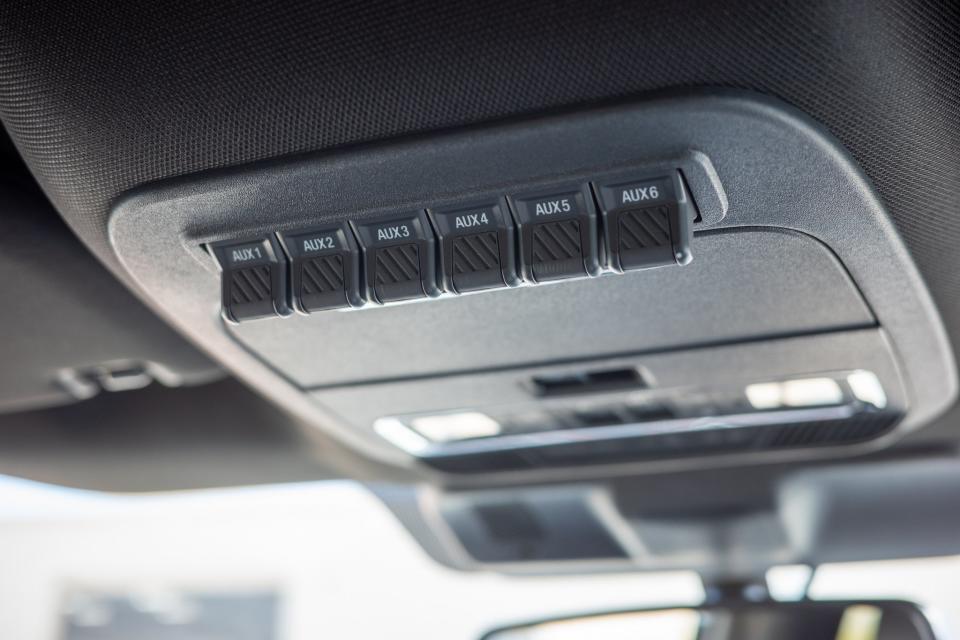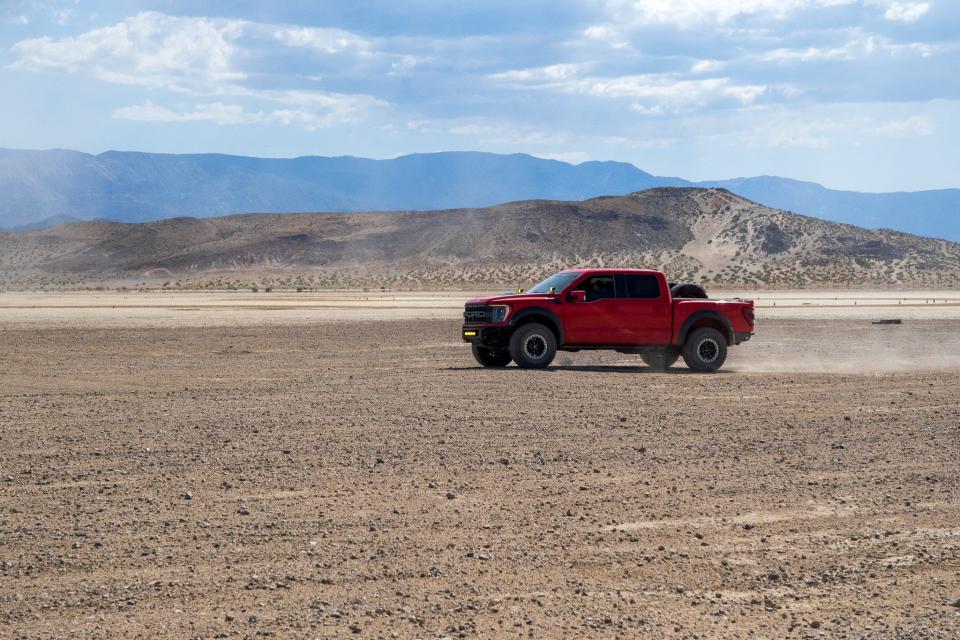2024 Ford F-150 Raptor R First Drive Review: Hitting a Wall With the V8 Raptor

Ford has run into a problem with the 2024 F-150 Raptor R. When the third-generation Raptor debuted, fans hailed the return of the V8 into the engine bay of the baddest off-road truck around. It was a return to form for Raptor, which was originally conceived of by Ford SVT as a beast for bombing around the desert Baja-style, impulsed by an available 6.2-liter V8 but was saddled with an EcoBoost V6 in its second generation.
When Ford confirmed the third-generation Raptor would regain its powers in the form of the V8—like Superman basking in the glow of Earth's sun—fans rejoiced. The 2023 F-150 Raptor R was basically as close to the ideal of a Raptor as it could be. In Plato's heaven, the Raptor R is the full-size performance truck from whence all real examples of the truck materialize. But where do you go from there? How do you improve a machine that's at (or near) the peak of its performance?

Ford's answer to that question is a little more power and a revised suspension that yields slightly better control. For 2024, the F-150 Raptor R gets a power bump of 20 horses and its Fox Dual Live Valve shocks now control rebound more accurately. Ford rounds that all out with a facelift, which all F-150s received now that the truck is well into its 14th generation.
The design changes are mild and are part of the truck's mid-cycle refresh rather than a full-on redesign. That's not a bad thing since I still look for the subtle red "R" badge when I see these out on the road that signifies V8 status. Raptors are common but the Raptor R less so, and Ford thankfully refrained from making the V8 broadcast its presence. Insofar as the F-150 Raptor can be loud and showy, the Raptor R speaks softly and carries a big stick.
That much is still true for the refreshed version, which got small tweaks in the design. The Raptor R's front end looks bigger and now shares some of its looks with the F-150 Platinum. The grill and lights still span the length of the front end, overflowing to the Raptor's fenders but they are inset to make their design seem sculpted into the Raptor's snout rather than thrown on haphazardly. It works well, and, of course, the orange marker lights that many of Ford's rivals have copied are still there.



The Raptor R is getting a little more flashy with new graphics, which is OK. I'm not a fan of boasting of one's presence but I am willing to fly my freak flag with '80s and '90s graphics, which were ebullient celebrations of the cars that wore them. The Raptor R gets similar new graphics on the hood and elsewhere to set it apart from its twin-turbo V6 EcoBoost siblings while keeping the large hood scoop, a characteristic feature of the V8-powered trucks.
Oh, and the Raptor R gets a new option for a modular bumper that owners can upgrade by adding a winch, light bar, or other accessories in a mix-and-match configuration. Only the F-150 Raptor and Tremor are getting these bumpers among the full-size truck's lineup. But the Raptor gets an extra touch as designers tweaked the bumper end caps for a better view of the truck's 37-inch BF Goodrich All-Terrain T/A KO2 tires from a head-on perspective. As if the Raptor's big boots needed any more attention. But it actually looks rad and makes the truck look even more Baja than before.
Ford says the hood scoop is part of the Raptor R's optimized air intake system, which helped engineers squeeze more power from the engine. The Raptor R's 5.2-liter supercharged V8 now makes 720 horsepower and 640 lb-ft of torque. That's an increase of 20 horses over the previous model courtesy of "reduced air inlet losses" and an optimized engine calibration for a wider torque curve, according to Ford. The Raptor R still uses a 10-speed automatic transmission with two coolers, though it differs from all other F-150 models by using a planetary gear set borrowed from the F-250. The transmission is excellent, and using the paddle shifters is not necessary but still fun.






Most people won't use the paddle shifters but it's fun to drop a gear and watch the needle surge on the dash. It adds to that feeling of being in an off-road race, an illusion that's quickly dispelled by the Raptor's cabin. That's probably one of the major differences between a Raptor R and a much more expensive purpose-built racing machine: the Raptor R is pretty much a luxury vehicle inside, featuring rich surface textures such as leather and Alcantara on available Recaro bucket seats.
Infotainment comes in the form of a massive 12.0-inch center screen and a 12.0-inch digital gauge cluster. Ford's UI does a good job of segmenting Apple CarPlay and Android Auto into one section of the screen while still showing you some of the truck's metrics. But making use of all the detailed off-road info and onboard cameras on the trail means giving up CarPlay while you're out 'wheelin.
The Raptor R has some of the most advanced 4x4 tech to ever grace a full-size truck both in the cabin and under its sheet metal with selectable drive modes and an on-the-fly automatic four-wheel-drive system but the truck's suspension is a big part of what makes it so special. The Raptor R will now get shocks that use Fox's Dual Live Valve tech, rather than the previous Live Valve shocks.



These shocks aggressively control the down- and up-stroke of the dampers—both compression and rebound—and they continuously adapt to driving conditions. What you get is better control of the Raptor's mass as the truck bombs through dunes and washes, or whatever high-speed trail you throw at it. The rear suspension is still a five-link coil rear with extra long trailing arms and 24-inch coil springs. Rear suspension travel is 13 inches and 14.1 up at the front. Overall ground clearance is 13 inches thanks to the truck's 33-inch tires and 17-inch beadlock-capable wheels.
The Raptor R's suspension and engine upgrades add up to a small evolution for the off-roader rather than a revolutionary change. The changes are subtly noticeable compared to the outgoing model, and if I were a better driver, I'm sure that they would shave a few tenths of a second off lap times in Johnson Valley, where Ford let us push the Raptor R to the fullest extent of our abilities—not the truck's. The Raptor R far exceeds my capabilities and I'm sure it would take years for me to grow into the machine as a driver.
Given my experience, it was probably more placebo than empirical, repeatable results when I felt like I was going faster and carving more technical lines in the course that Ford let us rip on. In the new Raptor R, I could brake just a little later and turn just a little harder—and, yes, recover the rear a little easier when I inevitably let the lure of the engine's power get the best of me. The 5.2-liter V8 goads you into matting the accelerator pedal. But no matter how hard I drove it, the Raptor R just hunkered down and asked for more. It's a conduit of horsepower that anchors itself to the Earth and lets you live out your fantasies as a trophy truck pilot.





Speaking with Ford consultants who double as racers in the Mint 400, King of Hammers, and other SCORE off-roading races, it seems that the Raptor R has been welcomed by the community as a rig that blurs the lines between a production vehicle and a motorsport machine. It's truly that good. Then again, it always has been ever since the Raptor R was released. The flies in the soup are, of course, that the Raptor R has lower towing and payload capabilities than other F-150s. If you want to do actual truck things, get a Tremor. The other issue is that the 2024 F-150 Raptor R starts at an eye-watering $112,220. That's a lot of money to live out your desert-racing dreams, but it's basically the only ticket in town for its specific niche.
The Ram TRX is no longer around, and the upcoming release of the Ram RHO curiously tracks with the Raptor's own trajectory of downsizing from a V8 to a six-cylinder. When I asked Ford what they think of the Ram RHO, they were dismissive and unworried. Likewise, any of GM's full-size pickup trucks made for off-roading are not keeping Ford up at night any time soon. Models like the Chevy Silverado ZR2 currently just don't compare to the Raptor R.
To return to the question of how Ford can make the Raptor better, the answer is they don't. Not really. After throwing a supercharged V8 into the engine bay and adding a brilliant exhaust system to accentuate the sound and the fury, every improvement Ford can make to the Raptor R will be marginal. And that's where the 2024 Ford F-150 Raptor R has found itself. As far as problems go, Ford has a good one on its hands, but from behind the wheel, that means the Raptor R will struggle to get much better than it already is.
2024 Ford F-150 Raptor R Specs | |
|---|---|





Got a tip? Email us at tips@thedrive.com

 Yahoo Autos
Yahoo Autos 